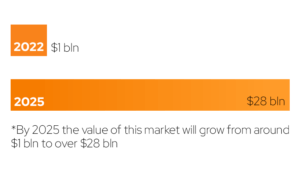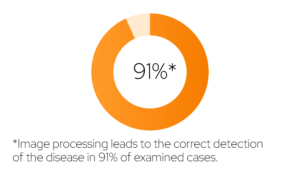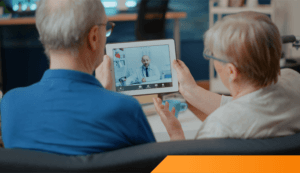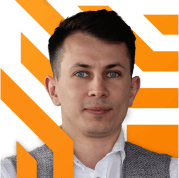
HealthCare – 3 examples of digital transformation
According to the survey conducted by Deloitte in 2020, digital transformation has a big impact on general business development. The highlighted areas relate to the financial performance of the company. By that, I mean revenue growth, profit margins, etc. The more digitally mature, the better. We as customers also perceive these changes and it’s tempting to use user-friendly, digital products and services.
5 min read
In this Article:
- Are machine learning algorithms and deep learning the best possible solutions to collect data?
- Is digital transformation an efficient tool to monitor health?
- Can IoT devices register numerous necessary health measures?
Healthcare is something different. In this industry, the main goal of introducing new technologies is far above the financial profits and providing joy to customers. Digital solutions shed new light on the time of diagnosis, quality of treatment, the chance of recovery, patient comfort, and more.
In this article, we will take into consideration 3 chosen examples of digital transformation in medicine. All for you so you can learn more about the milestones that are currently happening in the fundamental part of our life. OK, let’s start with artificial intelligence (AI).
Artificial intelligence
AI entered the world of healthcare strongly. The process is unstoppable – according to Statista, by 2025 the value of this market will grow from around $1 bln to over $28 bln. It’s all because machine learning algorithms and deep learning are the best possible solutions to collect data, process it, and provide the recipient with reliable results. It allows the high-ranking people in the world’s most influential healthcare companies to make strong, scientifically substantiated decisions.

The AI impact has a visible impact on numerous fields of medicine. They are, just to mention a few: radiology, screening, psychiatry, drug creation, and dermatology. I’ll explain the impact of AI on healthcare further in the following example.
When it comes to both radiology and dermatology, deep learning is widely used to detect skin cancer. It also presents high efficiency in estimating whether the disease is malignant or benign. According to the research made by PMC, image processing lead to the correct detection of the disease in 91% of examined cases.

We can only imagine how groundbreaking it could be for medicine. Let’s say, we could have the possibility of having a mobile app that can help in the right diagnoses of skin lesions just with a picture made by smartphone. And this is just the improvement in our private section. Deep learning will revolutionize the computer systems used in hospitals, medical centers, etc. This is how the doctors will know how to conduct a predictably successful treatment. All cards are on the table.
Telehealth
We keep hearing the worrying statistics about Omicron – the newest variant of SARS-CoV-2. The number of infections is growing, which means that all ways to keep us safe from the risk of infection remain up-to-date. Telehealth is a common example of such a procedure. According to McKinsey, the general popularity of it has grown 38x in comparison to the old days from before the pandemic. But what is it exactly?
Telehealth is a remote distribution of health services and information by electronic means. Digital telecommunication technologies are used here. Doctors can stay in touch with their patients with no need for personal encounters. Digital transformation is an efficient tool to monitor health, make decisions about the next steps of treatment, prescribe the right medicines, etc.

This section of digital transformation has developed to the level that you basically can think of any field of medicine, add the prefix tele- and, trust me, it will exist. Teledentistry, telecardiology, teleneurology, teleophthalmology are just some examples.
According to the same article by McKinsey, telepsychiatry is currently the most frequently used branch of telehealth. Psychotherapy can’t be disrupted for a second, and the peak of the pandemic was a big threat to such situations. Fortunately, the continuation of treatment was possible through webcams, phones, etc. and it was quickly adopted by both psychiatrists and patients.
The example of the strength and popularity of telepsychiatry comes from Great Britain. The National Online Psychiatry Service was launched there by NHS. People can get remote and fully private help with addictions, anxiety, depressions, personality disorders, and many other mental problems.
If I were to predict, such services can become a widespread solution in the nearest future. The pandemic is not going to withdraw from our life and telehealth allows you to take care of your health without leaving your house.
Internet of Things (IoT)
OK, so we know that telehealth is more about the direct contact between the doctor and patient. But what about gathering the information that helps in monitoring one’s health? Here, IoT is the answer.
IoT devices register numerous important health measures, including heart rate, blood pressure, temperature, sleep quality, etc. That’s beneficial for both sides – we can control our physical status daily, as well as the doctor has a complete picture of our health even at a distance. The data is gathered in a software app that can be used by both sides.
What is more, IoT devices are equipped with sensors that give the immediate signal whenever the metrics are above or below the standard. This is how a doctor has an opportunity to intervene in due time.

To give you a specific example, Statista predicts that in 2045 there will be about 700 mln of people diagnosed with diabetes worldwide. This is where IoT comes into action. There is a growing idea of creating an IoT-based continuous automatic glucose monitoring system. It means that soon the general awareness and control of the course of diabetes will be available on an unprecedented level.
Summary
Digital transformation is widely noticeable in modern medicine. The ideas of AI, telehealth, and IoT in medicine are already developed to the advanced level and the process doesn’t seem to stop any time soon. The comfort and efficiency of these solutions are the clearest perks.
I’m sure that you’ve been given a sample of the scale of the phenomenon. Examples of skin cancer detection, telepsychiatry, and monitoring glucose levels through IoT devices show how digital transformation influences healthcare. But to be honest, every branch of digital transformation deserves deeper research. Let’s see what will happen in 2022.
Do you have any questions to learn more about the 3 given examples of digital transformation? Feel free to ask!




